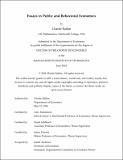| dc.description.abstract | This thesis examines how psychological forces and non-standard preferences affect poverty and the design of social welfare programs for low-income households.
The first chapter, "Eviction as Bargaining Failure: Hostility and Misperceptions in the Rental Housing Market" (co-authored with Evan Soltas), studies the causes of evictions from rental housing and the welfare impact of policy interventions to address them. Court evictions from rental housing are common but could be avoided if landlords and tenants bargained instead. Such evictions are inefficient if they are costlier than bargaining. We test for two potential causes of inefficient eviction — hostile social preferences and misperceptions — by conducting lab-in-the-field experiments in Memphis, Tennessee with 1,808 tenants at risk of eviction and 371 landlords of at-risk tenants. We detect heterogeneous social preferences: 24% of tenants and 15% of landlords exhibit hostility, giving up money to hurt the other in real-stakes Dictator Games, yet more than 50% of both are highly altruistic. Both parties misperceive court or bargaining payoffs in ways that undermine bargaining. Motivated by the possibility of inefficient eviction, we evaluate the Emergency Rental Assistance Program, a prominent policy intervention, and find small impacts on eviction in an event-study design. To quantify the share of evictions that are inefficient, we estimate a bargaining model using the lab-in-the-field and event-study evidence. Due to hostile social preferences and misperceptions, one in four evictions results from inefficient bargaining failure. More than half would be inefficient without altruism. Social preferences weaken policy: participation in emergency rental assistance is selected on social preferences, which attenuates the program’s impacts despite the presence of inefficiency.
The second chapter, "The Welfare Effects of Eligibility Expansions: Theory and Evidence from SNAP" (co-authored with Jenna Anders), studies the U.S. rollout of eligibility expansions in the Supplemental Nutrition Assistance Program. Using administrative data from the U.S. Department of Agriculture, we show that expanding eligibility raises enrollment among the inframarginal (always-eligible) population. Using an online experiment and an administrative survey, we find evidence that information frictions, rather than stigma, drive the new take-up. To interpret our findings, we develop a general model of the optimal eligibility threshold for welfare programs with incomplete take-up. Given our empirical results and certain modeling assumptions, the SNAP eligibility threshold is lower than optimal.
The third chapter, "Preferences for Rights" (coauthored with Aviv Caspi and Julia Gilman), observes that public discourse about in-kind transfers often appeals to "preferences for rights" — for instance, the "right to health care" or "right to counsel" for indigent legal defense. Preferences for rights are "non-welfarist" if the person values the right per se, holding fixed how the right instrumentally affects others’ utilities. We test for non-welfarist preferences for rights, and their relationship to redistributive choices, with incentivized online experiments (N = 1,800). Participants face choices about allocating rights goods (lawyers, health care) and benchmark goods (bus passes, YMCA memberships) to tenants facing eviction. We implement a share of choices. In two of three experiments, more than half of participants allocate rights goods in ways that are consistent with preferences for rights and dominated if preferences were entirely welfarist. Dominated behaviors are more common with rights goods than benchmarks. In a fourth experiment, those with preferences for rights also exhibit "anti-targeting," where they redistribute lawyers and health care more universally than benchmark goods to recipients whose incomes differ. At least 26% of participants are non-welfarist, while at most 31% are welfarist. | |
